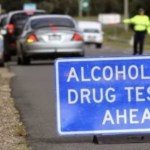Court Suppresses Name of NSW Police Inspector Charged with High-Range Drink Driving

A New South Wales Local Court Magistrate has granted a suppression order in favour of a high-ranking police officer who is alleged to have driven his police-issued vehicle while driving with a high-range prescribed concentration of alcohol, collided into a barrier and fled from the scene.
The story so far
It is alleged that after drinking an estimated 20 alcoholic drinks during an evening function at The Rocks in the Sydney CDB in May this year, the 46-year old police inspector entered the vehicle and drove onto the NorthConnex at 1.54am before exiting into a street in Wahroonga in the Upper North Shore and crashing into a barrier.
The officer is alleged to have left the vehicle at the scene.
Police then commenced their investigations and charged the inspector last week, six months after the incident, with high range drink driving as well as driving under the influence of alchohol.
An expert report has estimated his blood alcohol concentration at the time of driving at between 0.280 and 0.320 – which is double the high range threshhold of 0.150.
The officer is set to face Hornsby Local Court over the allegations next month.
What’s the difference between drink driving and DUI?
As a side-note, the difference between driving with a prescribed concentration of alcohol, commonly known as ‘drink driving’, and driving under the influence of alcohol or another drug, commonly known as DUI, is that the former charge is brought on the basis of a particular blood alcohol concentration – whether special range, low range, mid range or high range – while the latter offence does not require a specific alcohol reading but does require proof that alcohol or another drug actually influenced a person’s manner of driving.
Police protect their own
Information regarding the incident was leaked to the mainstream media earlier this week, which caused a number of questions to be asked including why it took so long to charge the officer.
But rather than be transparent about the incident, the New South Wales Police Force closed ranks and used their enormous media influence and taxpayer-funded resources to protect the officer and shut down adverse reporting about him.
In that regard, New South Wales Police Commissioner, Karen Webb, who has made a name for herself for not being particularly “media friendly”, took the initiative to front the media earlier this week to deny any suggestions of a cover-up.
“We had to wait for the legal process to takes its course, and I can’t make that go any quicker. So any suggestion that there’s a cover-up or interference, I reject”, the state’s highest ranking police officer told tabloid radio station 2GB.
When asked why no information was released about the incident until after the mainstream media got hold of it, when it is police policy to make certain details of such incidents available to the public, Ms Webb stated:
“It probably could have gone out on Friday and I’ve asked for a review to be done of that to see why it fell through the cracks and what happened there”.
But more than this, the New South Wales Police Force made an application to the court to keep the identity of the officer hidden from the public.
This is very different to situations where regular members of the public are charged with criminal offences, or even falsely suspected of offences, where police will often be very happy to disclose details and proactively front the media to brag about their ‘achievements’.
The force also issued the following public statement:
“Following extensive investigations, a Future Service CAN (court attendance notice) was issued to a 46-year-old man. The off-duty inspector, attached to a specialist command, was issued a Future Service CAN drive under the influence and a Future Service CAN for drive with high-range PCA.”
Police have assured the public the inspector’s position is now “under review”.
Police watchdog steps in
The attention to the case has now triggered the state’s police watchdog, the Law Enforcement Conduct Commission, into action, and an inquiry into the incident is set to commence.
However, it is important to note the watchdog is chronically under-resourced and has no power to discipline let alone criminally charge anyone for an offence, whether misconduct in public office or otherwise.
And while the organisation can make recommendations to law enforcement bodies such as the police and Office of the Director of Public Prosecutions, it cannot compel them to act on these.
Suppression order granted
The application for a suppression order came before Hornsby Local Court earlier this week, at which time Magistrate David Williams asked everyone not directly involved in the case to leave the courtroom.
What transpired within the closed courtroom is not known, but his Honour ultimately Magistrate Robert Williams ruled in favour of police, granting temporary name suppression.
He ruled that the officer can only be identified by the pseudonym ‘AB’, but the name suppression is only granted for the next fortnight, until a full hearing can take place.
The officer’s drink driving charges are due to be heard in the same court on 21 December 2023.
Suppression orders in New South Wales
The power of courts to grant suppression orders and non-publication orders is set out in the Suppression and Non-Publication Orders Act 2010. Under this Act, all courts and tribunals can prohibit or restrict the publication or other disclosure of:
(a) information tending to reveal the identity of or otherwise concerning any party to or witness in proceedings before the court or any person who is related to or otherwise associated with any party to or witness in proceedings before the court, or
(b) information that comprises evidence, or information about evidence, given in proceedings before the court.
In deciding whether to make a suppression order or non-publication order, a court will take into account the primary objective of the administration of justice.
Under Section 7, Courts will take into consideration the following factors:
- i) information that would identify or is otherwise concerned or associated with a party to or witness in proceedings before the court, or
(ii) information that comprises evidence, or information about evidence, given in proceedings before the court.
Under what circumstances do courts grant suppression orders?
Section 8 requires the court to specify the ground/s on which an order is made, which are set out in section 8 (1):
(i) the order is necessary to prevent prejudice to the proper administration of justice,
(ii) the order is necessary to prevent prejudice to the interests of the Commonwealth or a State or Territory in relation to national or international security,
(iii) the order is necessary to protect the safety of any person,
(iv) the order is necessary to avoid causing undue distress or embarrassment to a party to or witness in criminal proceedings involving an offence of a sexual nature (including an act of indecency),
(v) it is otherwise necessary in the public interest for the order to be made and the public interest significantly outweighs the public interest in open justice.
Contempt of Court
If a suppression order or a non-publication order is breached, it can be considered “contempt of court”.
Contempt of court is a criminal offence under section 24 of the Local Court Act 2007. It carries a maximum penalty of 28 days in prison and/or a fine of 20 penalty units.
Because contempt proceedings are criminal in nature, the court must be satisfied to a reasonably high degree that the offence was committed and that the person responsible for publication knew that an order had been made.
The potential for interference in the justice process is considerably high these days, given the rise in social media, but there have also been instances where media has known about non-publication orders and proceeded anyway. Most recently, a number of media outlets were accused of ignoring a publication embargo on the final report by Walter Sofronoff, KC into the trial of Bruce Lehrmann. To date, these allegations have not been substantiated.
In 2021,a number of Australian media organisations were collectively fined more than $1m for contempt of court over their coverage of George Pell’s sexual abuse conviction. The conviction was strictly suppressed because George Pell still had other cases pending in the courts.








